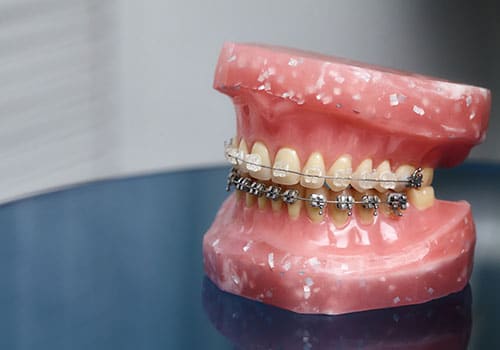Medicaid provides health care benefits for many low-income families and individuals. Medicaid is a program funded jointly by the federal government and each state. With many children and adults today needing braces for dental correction, you might wonder whether Medicaid covers braces.
The answer depends on several factors. The place you live can affect coverage, as can your specific diagnosis. If you need braces, keep reading! We will give you all the details on whether they will be covered by Medicaid and some other options for paying for them.
Will Medicaid Pay For Braces?
So, does Medicaid pay for braces or other dental services? One of the most significant determining factors is the age of the patient. Therefore, we will examine coverage for braces separately for children and adults below. Many people wonder how to get free braces with Medicaid, so here is what you need to know when it comes to getting braces covered by Medicaid.
Medicaid & Braces For Children
Under the EPSDT program, Medicaid provides many benefits to children that are not offered to adults. These services provide dental care, screening, and preventive services to children under 21 in every state. This can include braces!
However, the medical necessity of the braces will determine whether Medicaid will cover them. If braces are deemed medically necessary for your child, then Medicaid will cover them. Medical necessity will be determined by a dentist or orthodontist registered with the American Association of Orthodontists.
There are several different reasons why braces might be medically necessary. Cosmetic reasons will not qualify your child for coverage under Medicaid. Your orthodontist will examine your child’s records and condition to determine the necessity. Here are some conditions that will usually deem braces medically necessary:
- Cleft palate
- Cleft lip
- Severe overbite, underbite, or crossbite
- Structural jaw issues
- Overjet teeth
- Problems eating or chewing
- Malocclusion
If your child has any of the medical conditions above, he or she is likely eligible for orthodontic treatment that Medicaid will cover. However, Medicaid will typically only cover metal braces, not clear or ceramic braces.
Once you know that Medicaid will pay for braces, you must find an orthodontist who accepts Medicaid. Finding a doctor who accepts Medicaid can be complicated, but you can typically visit your carrier’s website to find an online directory.
Medicaid & Braces For Adults
Are you wondering,” Does Medicaid cover braces for adults?” Getting Medicaid to pay for braces as an adult is more complicated. In some states, Medicaid does not provide any dental coverage for adults. In those states, you cannot get Medicaid to pay for your braces regardless of medical necessity.
However, some states provide oral health benefits for adults as well. In those states, your braces must be deemed medically necessary, and it can sometimes be difficult to pass that threshold as an adult. Some conditions that might qualify you for coverage would include the following:
- TMJ
- Sleep apnea
- Broken jaw
Simply because you want braces to correct the spacing between your teeth would not qualify you for coverage. Your eligibility as an adult will be limited to only those severe cases where braces are required for medical reasons.
KEY TAKEAWAYS
- Medicaid is a program funded jointly by the federal and state governments, and each state is authorized to determine coverage details.
- Generally, all state Medicaid programs will cover braces for children if deemed medically necessary to treat an illness or injury, such as cleft palate, cleft lip, severe overbite, jaw issues, and malocclusion.
- For children under 21, Medicaid also includes dental benefits for regular cleanings, x-rays, checkups and fillings.
Does Medicaid Cover Invisalign?
Unfortunately, Medicaid does not cover Invisalign and is limited to metal braces only. Metal braces are typically the cheapest option for orthodontic care. Most health or dental insurance plans (even private plans) provide lower benefits for Invisalign and other cosmetically appealing options.
Metal dental braces might not be the most aesthetically appealing option for some people, but those are the only braces usually covered by Medicaid. Some private or group healthcare coverage might provide benefits for Invisalign or clear braces. However, Medicaid will typically not provide any coverage for those devices. So, if you opt for something other than metal braces, you might be stuck paying the entire cost.
Must read articles related to Healthcare
- Steps to sign up for Medicare
- How do I find an eye doctor that accepts Medicaid?
- What is the difference between an HSA and an FSA?
- How might a Healthcare Proxy help you?
- Will Medicare or Medicaid pay for assisted living?
Medicaid Coverage Of Other Dental Services
So, what does the Medicaid insurance program cover regarding other dental benefits? Again, the answer might depend on your age. For children under 21, Medicaid provides dental benefits in every state. This includes regular cleanings, x-rays, checkups, fillings, and other dental services. It even includes orthodontic services when medically necessary.
- The Medicaid dental program is part of the EPSDT program, providing these and other services to children nationwide.
Dental services are only provided for adults in states that include this coverage in their Medicaid program. Many states do not provide dental coverage at all for adults.
You must pay out-of-pocket for dental services or enroll in standalone dental coverage. Since Medicaid receives part of its funding from the state government, each state gets to set its own rules regarding Medicaid coverage details.
TIP
In many states, Medicaid does not provide dental/orthodontic benefits for adults. You will be required to cover the cost of any braces 100%. Other options to help subsidize the cost of braces are private dental insurance, dental schools, and non-profits.
Other Options To Pay For Braces
So, if Medicaid won’t pay for your braces, what other payment options do you have?
Payment Plans
One option that many people use to help pay for braces is a payment plan. You can ask your orthodontist about any payment plans they offer to help you spread out the cost of your braces. Many offices will offer a free consultation where they can discuss your treatment options and the types of payment plans they offer.
Dental Schools
Another option for getting affordable braces is to visit a dental school near you. Dental students often need to perform certain procedures, and many dental schools allow people to utilize these services at little or no cost. This could be a great way to get braces at an affordable rate.
Non-Profits
Finally, you could apply for free braces through a private organization or non-profit whose mission is to help those who cannot afford them. Many organizations, such as Smiles Change Lives, allow you to apply for free braces through their program.
They use donations to help people pay for braces. Some programs are limited to children, while others may also include adults. There is no guarantee that your application will be approved, but these programs help many people afford braces who might not otherwise be able to get them.
Medicare is Not An Option
You should know that Medicare is not usually an option either—even for those with disabilities. Original Medicare does not provide dental benefits, which applies to orthodontic care. Remember that there are significant differences between Medicare and Medicaid. Medicare is available for seniors and people with disabilities, while Medicaid provides health coverage for low-income families.
The Bottom Line
Whether or not Medicaid will cover braces mainly depends on your age and whether or not the braces are medically necessary. In all states, Medicaid will cover medically essential braces for children.
However, getting braces covered for an adult is more complicated. Only a few states offer Medicaid coverage for braces, and you must have a severe condition that requires them.
If Medicaid does not cover your braces, you do have a few other payment options, such as private insurance or a payment plan through your orthodontist.
Frequently Asked Questions
The average cost of braces is around $5,000 to $6,000. The length of treatment you require and the specific type of braces you need will affect the price. Clear braces, ceramic braces, and Invisalign are usually more expensive.
If you require other orthodontic procedures as part of your treatment, the cost will also increase. Most private insurance plans will cover a portion of these charges, and you might be able to get the cost fully covered by Medicaid in some situations.
Yes, most dental insurance plans provide some coverage for braces. Although the cost is not likely to be covered 100%, your dental insurance will probably pay for a large portion of the expense, which can greatly help with the cost of braces.
You should also know that most dental plans have a lifetime limit on expenses related to orthodontic care. This means that once you have used your full benefit, your plan will not pay for more orthodontic treatment.
An orthodontist or dentist will typically decide whether braces are medically necessary. It usually means that you have a medical condition that requires treatment through braces.
Simply getting braces for cosmetic reasons, like straightening teeth, is not enough to meet the definition. Some medically necessary reasons include TMJ, cleft palate, severe overbite, severe underbite, and others. If your child has a medically necessary reason for braces, then Medicaid will cover them.
Getting Medicaid to pay for your braces is much more challenging as an adult. Only a few states offer coverage; even in those states, your condition must be severe enough to warrant braces.
You can find a Social Security Administration office near you by using our SSA office locator and searching for your closest location.






